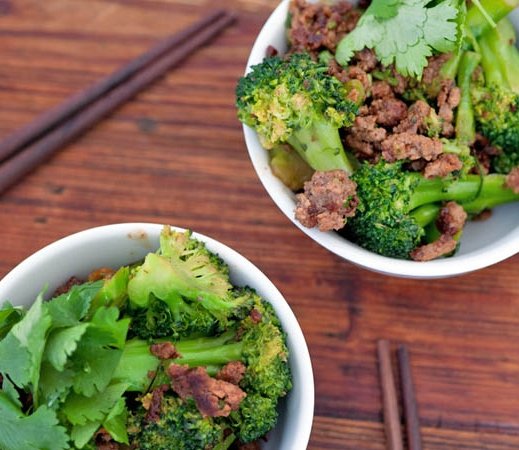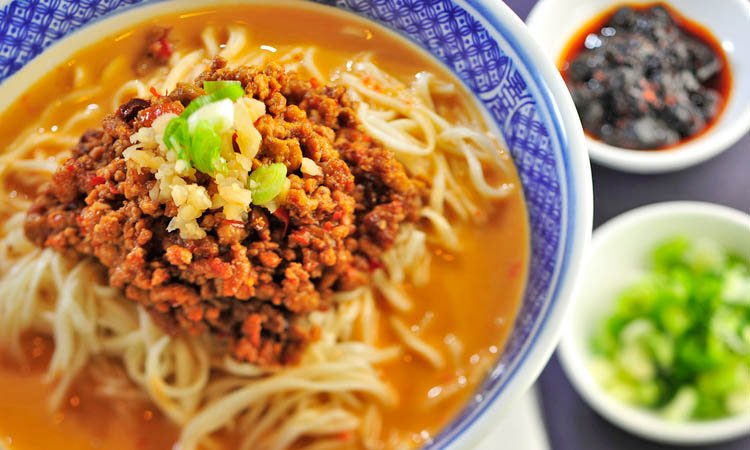Chinese Recipe: Beef With Broccoli

Beef With Broccoli is a classic when it comes to chinese cooking. It makes a perfect plate for almost all occasions.
Ingredients:
Marinade for Beef:
1 egg
1/3 tsp salt
1 Tbsp cooking wine
1 Tbsp cornstarch (corn flour)
2 Tbsp water
3/4 lb lean beef sliced thinly into bite-sized pieces
1 1/2 Tbsp oil
1 1/2 lb broccoli, flowerets removed, slice on the diagonal into thin slices
1 cup cooking oil
2 1/2 Tbsp oyster sauce
2 Tbsp light soy sauce
3/4 Tbsp dark soy sauce
1 Tbsp sugar
a few drops of sesame oil
2 cloves garlic, crushed
1/2 cup chicken broth
2 Tbsp cornstarch
Directions:
Slice beef and mix together marinade ingredients. Add marinade to beef and marinate for thirty minutes. Add 1 1/2 tablespoons of oil to beef, mix in thoroughly, and marinate beef for another thirty minutes. While beef is marinating, prepare the vegetables.
Heat wok and add 1 cup of oil. When oil is ready, add beef and stir-fry until it is nearly cooked. Remove beef and set aside on a plate. Drain the wok and wipe clean with a paper towel.
Add 1/2 cup water to wok. Bring the water to a boil and add the broccoli. Cover and cook until broccoli is cooked through. Drain the wok.
Heat wok and add oil (about 2 tablespoons). Add the garlic and stir-fry for about 1 minute. Add vegetables and beef and mix together. Make a well in the middle of the wok and add the sauce ingredients. Add cornstarch, stirring to thicken. Mix sauce together with other ingredients. Serve hot.
Asian Cuisine Related Articles
Szechuan Cuisine

Dandan noodles: A popular Szechuan dish usually made of a spicy sauce
The cuisine of the Western region of China is well-known for its spiciness, but many Western palates overlook the complex interplay of savory, sour, hot and sweet flavors that underlie the fiery spice of the Szechuan pepper and other spices that give the Szechuan cuisine its characteristic burn.
For decades, most of the world was familiar mainly with Cantonese cuisine, and thought of it as ‘Chinese cuisine’. In reality, though, China is an enormous country that encompasses nearly every kind of climate imaginable. The amazing variety of foods, spices and climates have led to many distinct styles of Chinese cuisine. Szechuan cuisine, originating in a steamy, sub-tropical climate, includes smoked, pickled and spiced foods, as well as foods spiced with a heavy hand for both preservation and flavor.
While the Szechuan pepper, a fruit that grows in the Chongging province, has always been used in Szechuan cooking, most agree that it wasn’t until Christopher Columbus brought the chili back from his travels. Besides the flavors that sear the mouth, Szechuan cooking uses an interplay of flavors to create the full impact of a dish. Hot and Sour Soup, for instance, when prepared properly is neither exclusively hot, nor ultimately sour. Prepared with sorrel, lemongrass, tofu and other spices, its first impression is the heady, rich scent of roast meat and sour lemon. That aroma is belied at the first touch on the tongue – the soup is salty first, though not intensely so. The subtle blending of flavors melds, changing in the mouth to mildly sour – the sorrel and lemongrass making themselves known. It is not until the mouthful of soup has been swallowed that the fire sets in as the chili oil finally seeps into the taste buds.
This is not unusual for Szechuan cooking. The first mouthful of Kung Pao chicken seldom brings tears to your eyes. It is only as you chew and swallow and take yet another bite that the true heat of the dish begins to assert itself. Double Cooked Spicy Pork seems almost bland at first, with the flavors blending subtly in the background until the intense fire of the chili oil in which the pork is fried suddenly flames in your mouth.
There’s more than fire to Szechuan cuisine though. Smoked meats are common, and the smoking often makes use of unusual materials and flavors. Szechuan Tea-Smoked Duck is a delicacy that combines the flavors of citrus and ginger and garlic, juxtaposing them with a long, slow cooking over a fire laced with oolong and green tea leaves. The result is a succulent meat that melts in the mouth and leaves behind a hint of gingered orange.
One tradition of Szechuan cuisine that is becoming more common in the Western world is the Szechuan Hot Pot. Similar to a ‘fondue’, a Hot Pot is more an event than a meal. Chunks and slices of raw meat, seafood and vegetables are offered to diners at a table that holds a ‘Hot Pot’ – a pot of chili oil over a flame. Each diner selects their food and dips it in the chili oil until it is cooked. Often, hosts will also offer a pot of simple broth for those guests who prefer a more bland meal, or can’t tolerate the spiciness of food fried in chili oil.
Savory, rich and spicy, Szechuan cuisine is cuisine based on intensity – intensely hot, intensely sour, and intensely delicious.
Asian Cuisine Related Articles
Indian Tandoori

Traditionally, tandoori dishes are cooked in a tandoor, an oval shaped clay oven with a small fire in the bottom. The heat rises gradually but ultimately reaches a much higher temperature than a barbeque.
A tandoor is normally used to cook naan bread, meats and kebabs (meat or paneer). The bread is stuck to the sides, the kebabs stood vertically and whole chickens rested on a grid over the fire.
For domestic cooking, a tandoor is not really convenient but the meat dishes can be reproduced on a barbeque or in the oven. The bright red appearance of tandoori meats which you may see in Indian restaurants is produced by a food dye which really isn’t necessary to enhance the look of your tandoori dishes.
I have a great fondness for tandoori style food. It has flavour, without being “hot” or high in calories or too filling. In fact it’s an ideal dish summer or winter, if you fancy something a little different. As a bonus, it doesn’t take hours to prepare. Of course you can take all the effort out of it and use a pre-prepared mix, but I think they have less flavor and you can’t use them for anything else, whereas if you use the individual spices, you can make other dishes as well.
You can easily make tandoori chicken (whole), tandoori lamb chops (pork would be more unusual, but there’s no reason why you shouldn’t use it, if you prefer) and lamb tikka (kebabs) but my personal favorite is chicken tikka because it’s so quick so here’s my own recipe.
This recipe serves two people – multiply it for as many people as you want.
Ingredients
2 Chicken breasts
1 small tub Greek yogurt
1 tsp ground cumin
1 tsp ground coriander
½ tsp ground turmeric
½ tsp ginger powder
½ tsp chilli powder (or to taste)
1 small clove garlic, crushed
salt to taste
1 tbsp lemon juice
Directions
Cut the chicken breasts into 1 inch cubes and set aside.
Mix the spice powders and garlic into the yogurt. You can use low fat yogurt if you prefer. You can also use fresh ginger or ginger paste from a jar rather than ginger powder but go easy on the quantity as it can be quite over-powering.
At this point you can also mix in the salt and lemon juice but if you do so, don’t leave the chicken to marinade for more than about 20 minutes or it will become very dry when cooked. If you want to marinade it for a longer time, add the salt and lemon juice just before you cook the dish or sprinkle on to serve.
Thread the chicken onto skewers and either barbeque or cook under a grill using medium heat until the chicken is slightly browned and cooked through.
For a light meal, serve with salad, pitta or naan bread and lemon wedges or for something more substantial with rice and dahl.
Asian Cuisine Related Articles
Sushi: The Japanese Delicacy

Sushi is a Japanese dish, popular all throughout the world. Sushi lovers, young and old alike, mistakenly think Sushi refers to raw sea fish. Sushi actually means vinegar-flavored rice and the raw food accompanying it are called Sashimi.
Types of Sushi Preparations
There are five kinds of Sushi preparations like Nigiri, Maki, Temaki, Chirashi and Inari Sushis. Sushi rice is the staple ingredient in all of them. The types are determined by the kind of fillings or toppings used. The same ingredients can be served, assembled in both traditional and modern ways.
Nigiri Sushi is the most popular form of Sushi. It is served with an oblong mound of rice topped by wasabi and a thin slice of egg, seafood or any meat. While the egg is always served cooked, the seafood and the meat may be raw.
Maki Sushi is served rolled in nori, which is a kind of pressed seaweed. The rice, seaweed and the toppings are rolled into a cylindrical shape using a bamboo mat. The roll is then sliced into various thick and thin pieces. The California and Boston rolls are examples of this Sushi.
Temaki Sushi is similar to Maki except that it is hand rolled into a cone and is not chopped into small pieces.
Chirashi Sushi A rare Sushi, it consists of a bowl of rice with toppings of Sashimi or raw seafood or fish.
Inari Sushi Rare than even Chirashi are served as fried pouches of tofu stuffed with rice.
Ingredients for cooking up the best Sushi preparations
Rice: All Sushi preparations use short – grained Japonica rice mixed with a dressing of rice vinegar, sugar, salt, kombu and sake. The right stickiness is its essential quality.
Nori: These are wrappers made from sea weed, a type found in Japan. It is toasted before use. Nori by itself is edible. There are many kinds of ‘nori’ but the best quality is used in Sushi.
Toppings used in Sushi
Fish: For culinary, sanitary and aesthetic reasons the fish eaten raw must be fresher and of higher quality than fish which is cooked. In fact, professionals are employed to select the fish. Fish served raw are sea fish like tuna, mackerel and salmon. Fresh water fishes are cooked and never eaten raw since they are likely to contain parasites. The most valued Sushi ingredient is “toro”, the fatty cut of tuna. Toro comes in many qualities.
Sea food: Squid, octopus, shrimp and various shell fishes are used for sea food.
Vegetables: Pickled Daikon radish, pickled vegetables, fermented soya beans, asparagus, yam, tofu and gourd are some of the topping vegetables.
Red meat: Beef, ham, sausage and horse meat, often lightly cooked, are used for toppings.
Eggs: Slightly sweet layered omelettes and raw quail eggs are used as toppings.
Condiments used for preparing Sushi
The three main condiments are:
– shoyu which is soy sauce
– “wasabi” which is the grated root of the “wasabi” plant. Real “wasabi”, called “hon-wasabi” has anti-bacterial property which prevents food poisoning.
– “gari” which is sweet pickled ginger, cleanses the palette and aids in digestion.
Presentation is most important
Traditionally Sushi is served in an austere style in single or double tone colored plates. In smaller Japanese restaurants, plates are dispensed with, and the dish is had straight from the wooden counter. However in many places, particularly in U.S., a European sensibility has been imparted in to Sushi serving, resembling French cuisine.
Asian Cuisine Related Articles
